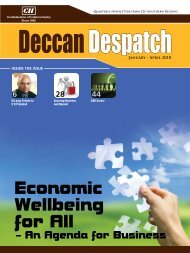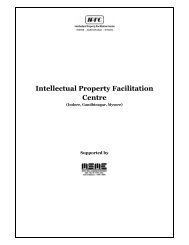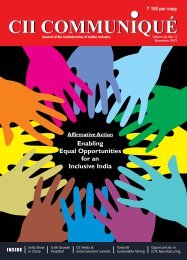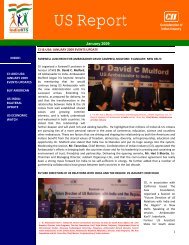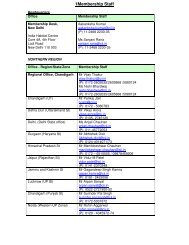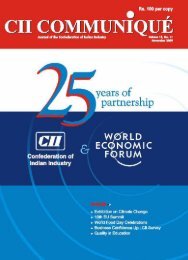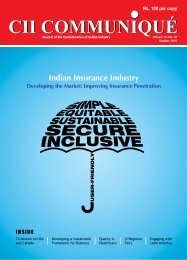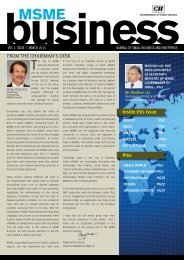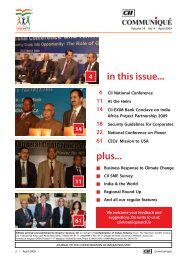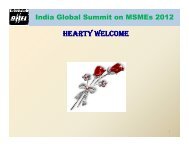Create successful ePaper yourself
Turn your PDF publications into a flip-book with our unique Google optimized e-Paper software.
ForewordWhen we revamped this newsletter about 3 years ago, we hadno idea we will be increasing its frequency from 4 issues to 5issues a year – the number of initiatives made this imperative.Inaugurated by Shri Sharad Pawar, Union Minister ofAgriculture, the 9th edition of AgroTech in December 2010saw new dimensions for Agri India. 40,000 farmers from 10states expanded their horizon by interacting with progressivefarmers, live demos of good agri practices, conferences, while6 countries showcased their products at the Show. MoUs worth` 5.5 crore were signed and 200 new products launched.There were several firsts at the AgroTech 2010. For the firsttime, 250 women farmers from Una district of HimachalPradesh visited the Show. A Buyer Seller meet to strengthenthe business aspect at AgroTech brought 13 buyers from 6countries to interact with 150 potential Indian partners. Anew show Livestock Expo put the focus on Livestock industry.In a unique effort to improve the trade relations between Indiaand Pakistan and to promote inter personal ties, we organisedan Indo-Pak Expo dedicated to 'dostana', where 50 exhibitorsfrom India and Pakistan showcased a wide range of products.Discussions with Governor of Punjab and Rajasthan, HE ShriShivraj Patil, Chief Minister of Haryana, Shri Bhupinder SinghHooda, Agri Ministers of J&K and Punjab, Mr Ghulam Hasan Mirand Mr Sucha Singh Langah respectively, saw valuable policybasedsuggestions being tabled by <strong>CII</strong> and industry members.Rajasthan, Punjab and Haryana participated in the PravasiBhartiya Divas and the annual event strengthened the bondbetween Indians and its wide-spread diaspora.But it isn't all work here at the Confederation – these previousfew weeks were peppered with fun as we, in keeping withthe Indian spirit of 'a festival a day' frolicked through thespecial evening with Muzafar Ali, organised cricket matches,celebrated Lohri and laughed through stand-up comedy shows.Not to forget, the role of readers is of paramount importanceto maintain and enhance standards of this newsletter. Welook forward to your feedback...(CHARU MATHUR)2630CONTENTS4spotlightpolicy pulse- physical infrastructure- 75th cii nr business outlook survey- the indian health scenario- fmcg roadmap- discussion on agri policy of rajasthanstatescapecompetitivenessexploring horizonsreaching outYifete fiestateleboard10- pre budget memorandum submitted for HP, punjab & rajasthan3320283234Edited, printed and published byCharu Mathur, on behalf ofConfederation of Indian Industry (Northern Region)Sector 31 A, Chandigarh 160030Tel: +91-172-5022522, 2607228Fax: +91-172- 2614974, 2606259E-mail: ciinr@cii.inWebsite: www.cii.in
spotlightspotlightsustainable agriculture3-6 December, ChandigarhThe 9th edition of Agro Tech 2010, broughtwith it plethora of opportunities for the agroIndia. Striking the cord for the discussions onnew green revolution in the country, India’spremier biennial agro technology & businessfair had participation from 230 companiesfrom 9 countries in 6500 sqm exhibition areaunder 9 concurrent shows."The fair was jointly inaugurated by Mr SharadPawar, Hon’ble Minister of Agriculture,Government of India, Mr Bhupinder SinghHooda, Hon’ble Chief Minister of Haryana.<strong>CII</strong>’s Agro Tech is a regular feature…Ihave been here earlier too. It is a goodopportunity for farmers to learn aboutnew technologies & implements… theexhibition is good…and for seriousdiscussions on agri related issues.- Mr Sharad Pawar, Union Ministerof Agriculture, Govt of India4 C I I n o r t h e r n r e g i o n n e w s l e t t e rand Mr Sucha Singh Langah, Hon´bleMinister of Agriculture, Government ofPunjab. Mr Mohammad Asif Rahimi,Hon’ble Minister of Agriculture, Irrigation &Livestock, Government of Islamic Republicof Afghanistan and Rt Hon Patricia Hewitt,Chairman, UK India Business Council &Former Cabinet Minister for Women &Secretary of State for Health, UK were theGuests of Honour."Agro Tech’s theme ‘SustainableAgriculture’ is very apt as there is a direneed for 2nd green revolution. Moreattention is needed for soil health, poweravailability and seed replacements.- Mr Bhupinder Singh Hooda,Chief Minister, HaryanaMany new features have been addedin line with the theme "Sustainable". Theinternational participation has been huge,30% more than last year. Farmer & cropfocus is sharper.- Mr Salil Singhal, Chairman,Agro Tech 2010
spotlightBusiness Focus @ Agrotech 2010International Buyer-seller MeetThe International Buyer Seller Meet at Agro Tech 2010 attracted 13 buyersfrom 6 countries - China, Malaysia, Oman, Singapore, Thailand, and UAE.65 meetings were organised with 13 sellers.Interest areas: Basmati rice, Aromatic products, Packaged foods, Spices Fruits &vegetables, Baby cereal and ConfectioneryThere were 3 country specific meetings with potential clients(UK, France, and Germany).Focused conferences: Addressed by about 75 experts over 450representatives from Agro based industry government, academic institutions,and progressive farmers participated in these conferences on: Future of Indian Agriculture– Sustaining Indian Agricultural Growth; Agri Infrastructure: Imperatives to Growth; NewDrivers in Food Processing Sector; Emerging opportunities in the Dairy and Poultry Sector;Production Technology and Marketing & Post Harvest Management.MoUs• SAI Cold storage and Allround (India) Vegetable Processing signed an MoUworth Rs 5.5 Crores for setting up 8,000 MT multi storage with allsorting, grading, packaging and loading facilities for potato, onion, carrot and beat.The facility would be set up at Palanpur, Gujarat.• Mahindra & Mahindra’s Farm Equipment Sector (FES) announced a tie-up with M/sMaschio-Gaspardo S.p.A, Italy. As part of this agreement, Maschio will provide rotovatorsto Mahindra. Maschio will also manufacture other kinds of rotary tillage equipment forplanting, seeding, crop care and crop residue management for Mahindra AppliTrac.Product launches• 846 business enquiries generated which have an estimated businesspotential of about Rs 100 crores• About 200 new products launched / displayedFarmer Focus• About 40,000 farmers visited; majorly from 10 States - AndhraPradesh, Haryana, Himachal Pradesh, Jammu & Kashmir, Maharashtra, Punjab,Rajasthan, Tamil Nadu, Uttarakhand & Uttar Pradesh.• Special farmer delegation from Afghanistan visited the show and shared their experiencesin Kisan Goshthis• 250 women farmers from Una district of Himachal Pradesh benefittedfrom the showf e b r u a r y 2 0 1 15
spotlightreinvented• Focused on educating farmers on sustainableagriculture practices• Progressive farmers shared their success stories• Special session organised on ‘SustainableFarming for Small Farmers’• Live demo of Soil testing, usage of tensiometersto save water Emu birds, Quails, Turkeys,Guinea Fowls, Hydroponics Machine"• Sessions organised on Natural ResourceManagement – soil & water conservation, GreenHouse cultivation, organic farming etc"- Sardar Sucha Singh Langah, Hon’ble Minister of Agriculture, Government of PunjabI am very happy to see an international agro fair organized in Chandigarh. It is great pride for each one of us andespecially for the farmers of Punjab since it provides an opportunity of growth to Indian Agriculture by bringing thebest in the market at the doorstep.a joint initiative of <strong>CII</strong> & Mahindra Swaraj to address thewater related challenges in agriculture• Internationally acclaimed, Patil Brothers - Hemchandra Patiland Rajendra Patil shared their water saving technology ofdrip irrigation• Waterman of Rajasthan - Rajendra Singh shared his initiative ofcommunity driven de-centralised water management focusingon increasing the greenery through rain water harvesting inRajasthanAgri Resource Management - the first time showat Agro Tech, featured companies engaged inagriculture conservationa healthy ‘n’ wealthy affairApple Fest 2010 has provided an opportunity to the apple & other stone fruit growersfrom the hill states of Himachal, Uttarakhand and Jammu & Kashmir to displayand sell their products and explore & enter niche markets. The focused conferenceon Production Technology and Marketing & Post Harvest Management brought inscientific practices to the producers.6 C I I n o r t h e r n r e g i o n n e w s l e t t e r
spotlight• 900sqm of space, an increase of 30% from lastedition• 9 countriesInternational Participation• 5 Country pavilions - Canada, France, Germany, South Korea& United Kingdom• First time pavilions - France & South Korea"− Mr Pravin Lunkad, Chairman Livestock Expo 2010"Livestock Expo brings in different sectors of the industry underone roof - animal feed, feed additives, medicines, ayurveda &homeopathy for animals, and breeding of different types of birdswhich present plenty of opportunities to both visitors and exhibitors."• Also participating - Australia, Italy, Spain & USA"- Mr Mohammad Asif Rahimi, Minister of Agriculture, Irrigation & Livestock, AfghanistanI am amazed by Agro Tech 2010. I would like to invite <strong>CII</strong> to hold an Agro Tech in Afghanistan... Bring an Agri Mission fromIndia... Afghanistan has a lot to offer in agriculture.Best Display AwardsAgri ExpoSyngenta India Ltd1st PrizeCRI Pumps2nd PrizeApple FestGovernment of Himachal Pradesh1st PrizeGovernment of Uttarakhand2nd PrizeFood ExpoAdani Agri Logistics Ltd1st PrizeHerbal Trends2nd PrizeFood Tech ExpoAllround India Vegetable Processing Machines 1st PrizeCarrier Air-conditioning & Refrigeration 2nd PrizeInternational PavalionOerlikon-Graziano Spa1st PrizeCarraro Drivetech Spa2nd PrizeAgricultural Resource ManagementShaktiman-Tirth Agro1st PrizeAutomat Industries2nd PrizeFarm ServicesL & T Finance1st PrizeState Bank of India2nd PrizeLivestock ExpoGodrej Agrovet1st PrizeAyurvet2nd PrizeFarm Tech ExpoMaschio Gaspardo Spa1st PrizePreet Tractors Pvt Ltd2nd PrizeThe plaque for AgroTech 2012 to be held from 1-4 December2012 in Chandigarh, India, was unveiled by Shri Ghulam HassanMir, Hon’ble Minister of Agriculture, Government of Jammu &Kashmir at the valedictory session of Agro Tech 2010.
spotlightFMCG Forum 2010: The Game Changers18 November 2010, New DelhiThe central theme of the seminar, “FMCG Forum 2010: The GameChangers”, was the position of FMCG industry in 2020. The industrystanding at 130 Crore today, is all set to grow in another 10 yearsby 4 to 5 times to a strong INR 6000 billion level.Mr. Anand Kripalu, Managing Director, Cadbury India Ltd said,“While the 1st half of the year stood at 4 to 5%, the 2nd half grew twotimes. Based on current trend and with introduction of time sensitivechanges, 20% is there for the asking.” If today per capita spendingon FMCG is low, the next decade promises to be an explosion. Threeparameters need prime attention - 'Growth, Efficiency and Capability',he informed.Taking a look at the Rural Market for FMCG, Mr Pradeep Kashyap,CEO MART, also known as the father of Rural Marketing, informedthat 90% of the population comprises the rural market with 80% ofthe villages being currently connected. Today, the total sale of FMCGproducts in rural India equals that of urban India. As an example,he stated that Clinic Plus shampoo is highest selling shampoo inrural market. Already, in some areas of rural Haryana big marketchain outlets have come and brands are fighting for shelf space. Ifthe FMCG market has to take the leap forward in 2020 the ruralsegment cannot be ignored.Among the other eminent speakers were Mr Madhukar Sabnavis,Country Head, Planning and Discovery, O& M ; Ambi Parameswaran,ED & CO, Draftfcb Ulka Advertising; Sudhir Sethi, Founder Chairmanand MD, IDG Ventures, India; Naresh Malhotra, Operating Partner,Sequoia Capital; and, Mr Kunal Bahl, CEO, Jasper InnovativeMarketing Solutions and Mr Jai Sinha, MD, Booz and Co.f e b r u a r y 2 0 1 19
policy pulsepolicy pulsePhysical InfrastructureThe relationship between infrastructure development and economic growth is well established. Superior infrastructure reducescost of doing business and enhances the investment attractiveness of the State/region. The development experience of theIndian States, bears out the fact that States with better infrastructure facilities have witnessed rapid industrialization. For them,infrastructure development remains central to the economic objective of achieving higher growth rates.Infrastructure bottlenecks not only slow down growth but also increase the cost of doing of business thereby adversely impactingindustrial competitiveness. For example inIndia, logistics cost is around 13 per centInfrastructure in the Northern Regionof GDP, which is high compared to 9-10Northern Region (NR) All Indiaper cent in the developed economies 1 . Power Installed Capacity (in MW) 42,189 1,59,399Northern Region, encompassing theHydro – 31.6 Hydro – 23.1UT of Chandigarh, and States of Delhi,Thermal – 58.9 Thermal – 64.3Haryana, Himachal Pradesh, Jammu & Energy mix (in %)Nuclear – 3.8 Nuclear – 2.9Kashmir, Punjab, Rajasthan, Uttar Pradesh &Renewable Energy Renewable EnergyUttarakhand, is one of the largest regions inSources –5.7 Sources – 9.7the country. In addition to the geographicalexpanse, the region also has huge varietyof terrain, is landlocked creating addedlogistical challenges for the industry. GoodInfrastructure therefore becomes evenmore essential for the economic and socialprogress of the region.A look at summary indicators showsthat overall the Northern Region haskept pace with the infrastructuredevelopment across the country.National Highway Length (km) 20,220 70,934Length of NH in km/ 1000 sq km 20.0 21.6Total Rail Network (km) 19,311 64,015Length of Rail line in km/ 1000 sq km 19.1 19.5International Airports (No.) 4 14Domestic Airports (No.) 27 103Telephone Subscribers (Million) 192 621No. of Telephones/ 100 population 52.7 52.7Source: Central Electricity Authority (CEA), Ministry of Road Transport & Highways, Ministry of Railways, Ministryof Civil Aviation, Telecom Regulatory Authority of India (TRAI)However there are significantvariations across the region.Power: The total installed capacity inNorthern Region as of March, 2010, is42,189 MW. Of the current generationcapacity, the share of thermal hasremained the highest at about 58.9 percent. The share of renewable energy hasgone up from 1.19 per cent at the end of1KPMG – <strong>CII</strong> Report on “Competitiveness Through Efficient Logistics”March 2005 to 5.7 per cent presently, butstill continues to be much lower than the allIndia percentage. The share of hydro hasdeclined from 33.15 per cent at the endof March 2005 to 31.6 per cent at the endof March 2010 while that for nuclear hasremained more or less constant at 3.80per cent as compared to 3.63 at the endof March 2005.Despite having a share of 26.5 percent in the overall installed generationcapacity in India, the peak demandsupplydeficit is higher in northern regionat 15.4 per cent compared to all India(13.3 per cent).Within the region, Punjab, Uttar Pradeshand Jammu & Kashmir have the highestpower deficits of 24.3, 21.1 and 32.3 percent respectively. Uttarakhand (6.0 per cent)10 C I I n o r t h e r n r e g i o n n e w s l e t t e r
policy pulseand Haryana (7.4 per cent) also fall under the category of powerdeficit states but the deficit is much lower compared to Punjab, UttarPradesh and Jammu & Kashmir. The deficit situation in Haryana,Rajasthan, Uttarakhand, Delhi and Chandigarh is better comparedto the all India average. Himachal is the only power surplus Statein the region.70.5 per cent of the region’s power generation capacity isconcentrated in the States of Uttar Pradesh, Rajasthan, Punjaband Haryana.In terms of energy consumed by different sectors, it is observedthat there is high demand for energy from the industrial sector ofthe region, particularly in HP, Uttarakhand, Punjab and Haryanawhere industrial activity is booming. In the two lead agrarianStates of the region, Punjab & Haryana demand for energy foragricultural purposes is significant.The annual plan outlays of Northern States (for the year 2009-10) have given great importance to power sector. Rajasthanand Punjab have allocated 43.2 and 30.2 per cent of the totaloutlay to power sector alone. Uttar Pradesh has sanctionedaround Rs 60 billion to this sector. While the States like Jammu& Kashmir, Uttarakhand and Himachal Pradesh have allocatedlower amount (as a percentage of total plan outlay) for thepower sector.Roads: Northern region due to its expanse has low density ofsurface transport infrastructure facilities. In terms of density ofroad the region lags behind national average.The total length of national highways in the region is 20,220 kms.Rajasthan (5,722) followed by Uttar Pradesh (5,670), Punjab(1,739) and Himachal Pradesh (1,471) have the largest networkof National Highways (NH) in NR. Additionally, many of the statehighways have also been declared as national highways due tothe rising traffic on these stretches. The existing road networkis being upgraded and express highways and freeways beingconstructed along the key routes in Delhi and the NCR. The “GoldenQuadrilateral” project of the National Highways Authority of India(NHAI) directly connects Delhi to other major cities of the country.In case of states like Punjab (with total road network of 54,883km) and Rajasthan (with total road network of 1,85,043 kms)there has been good participation of private sector in the roadsector of the States on account of a strong policy and institutionalframework for PPP projects.Even Uttar Pradesh (with road network of 1,39,362 km) hastaken definite steps to improve its road network by launchingsome of the biggest projects in the country on a PPP basis likethe Yamuna Expressway and Ganga Expressway.Since Himachal Pradesh is a hilly State, roads play a vital rolein transportation. Of the total road length of 27,260 km, NHaccounts for 1,471 km.Also, the Public-Private Partnership (PPP) projects are playingan important role in the development of transportation sectorof the northern region. The NR States have been witnessing asignificant growth in number of projects in transport infrastructure.States with estimated costs of PPP projects worth more than Rs 1billion in the transport infrastructure development include Delhi,Haryana, Uttar Pradesh and Rajasthan. Among other States ofthe region, Jammu & Kashmir and Punjab also have significantPPP projects in the transport sector whereas Himachal Pradeshand Uttarakhand lag behind.Railways: The Northern Region has a total rail network of19,311 km. Punjab, Haryana and Uttar Pradesh have wellspread rail connectivity. Haryana has a railway-route lengthof roughly 1,595 kms. Punjab’s railway network spans over2,133 kms. Rajasthan has a total railway network spanning5,854 kms. However it is Uttar Pradesh’s rail network whichis the largest in the region as well as in the country. The Stateis well-connected to other parts of the country by a railwaynetwork spanning over 8,703 km.Airports: Out of total of 14 international airports in the country,the region has four international airports (Amritsar, Jaipur,Srinagar, and Delhi). Correspondingly 27 out of a total of 103domestic airports are located in the northern region. The regionaccounts for 22.7 per cent of the nation’s aircraft movement.Haryana, Punjab and UT of Chandigarh share airport atChandigarh, which is now being upgraded to an internationalairport. The project is jointly being undertaken by theGovernments of Punjab and Haryana.Telecommunication: Telecommunication plays a crucial rolein making the fruits of economic growth and developmentmore inclusive. In terms of total subscriber base (includingboth wire-line and wire-less), the share of NR is about 31 percent. However the region has a lower tele-density comparedto all India as measured by number of telephone connectionsper hundred populations.Delhi circle has the highest Teledensity (172) in the regionfollowed by Himachal Pradesh (79). Uttarakhand has thelowest teledensity, much lower than the other hill States in theregion – Jammu & Kashmir and Himachal. Uttar Pradesh hasthe largest subscriber base but a relatively low Teledensity.(This is an abridged version of the report titled, “Physical Infrastructure: AComparative Study of Northern States”. Requests for the complete documentcould be sent at erpd@cii.in)— ¤ —f e b r u a r y 2 0 1 111
policy pulse75 th <strong>CII</strong> Northern Region Business Outlook SurveyHIGHLIGHTS• As many as 74% of the respondents expect GDP growth of 8%or more as against 61% in the previous October-December2010-11 Survey, reflecting a very strong positive sentimentfor the economy.2. OUTLOOK ON BUSINESS PROSPECTSCurrent conditions vs the July-September 2010 (% ofRespondents)• Expectations of high inflation. 98% of the respondents expectinflation to be 5% or more, as against 90% in the previoussurvey.• Outlook for the current three months much stronger than theactual performance in the last three months.• Business prospects on key elements –capital investment,capacity utilization, sales, new orders & production are allexpected to improve further in the current three months• Positive sentiment on the export front. Optimism on value,production and new orders.• Credit availability remains an area of concern with 66% ofthe respondents expecting no increase in credit availability.33% of the respondents expect the cost of credit to increase.• Top three concern areas are cost & availability of labour, risinginterest rates, and inflationary conditions.Note: Respondents were asked to rate scores ranging from 0, 25, 50, 75 & 100(0 for significantly worse and 100 for significantly better)Business Expectation: January - March <strong>2011</strong> (% ofRespondents)• The survey is based on responses received from industry acrossthe Northern Region states and captures the outlook of theindustry across the Northern Region.1. OUTLOOK ON THE ECONOMYAs many as 74% of the respondents expect GDP growth of 8% ormore as against 61% in the previous October-December 2010-11survey, reflecting a very strong positive sentiment for the economy.Expectation on GDP Growth (2010-11) (% of Respondents)Note: Respondents were asked to rate scores ranging from 0, 25, 50, 75 & 100 (0for significantly worse and 100 for significantly better)In line with the bullish growth sentiments, the outlook for thecurrent three months is stronger than the actual performancein the last three months. More than 50% of the respondentsreported the current conditions as much better than the last threemonths for the Indian Economy, their respective sectors and alsotheir own companies.The expectation for the next six months is even better witheven a greater percentage of the respondents rating the next sixmonths as 75 & 100, as compared to the current conditions.12 C I I n o r t h e r n r e g i o n n e w s l e t t e r
policy pulse3. AVAILABILITY AND COST OF CREDIT4. VOLUME AND VALUE OF EXPORTSAvailability of Credit (% of Respondents)Volume of Exports (% of Respondents)The survey reveals credit availability as a concern area. 81% ofthe respondents did not witness any increase in credit availabilityin the last three months. 58% of the respondents expect no changein the credit availability as against 59% reporting no change in thelast three months. However, percentage of respondents expectingno increase for the current three months decreased to 66%.As high as 86% of the respondents expect an increase in volumeof exports and another 14% expect status quo. As against this, only52% of the respondents reported an increase in exports duringthe last three months.Cost of Credit (% of Respondents)Value of Exports (% of Respondents)Only 33% of the respondents expect the cost of credit to increaseduring the current three months and another 50% expectingstatus quo.There is similar optimism in terms of value of exports; with 81%of the respondents expecting an increase. This is higher than theexpectation level (68% of the respondents) recorded during theprevious survey for the period October - December 2010.f e b r u a r y 2 0 1 113
policy pulsehealthcare delivery, they are limited in their endeavour to improvehealthcare standards on account of the pathetic condition of theinfrastructure in the vast majority of the country.In 2000, roughly two-thirds of the hospitals in India were public.Most of these facilities can only provide basic care. With a fewexceptions, such as the All India Institute of Medical Studies(AIIMS), public health facilities are inefficient, inadequatelymanaged and staffed, and have poorly maintained medicalequipment. The number of public health facilities also isinadequate. For instance, as per a PWC report, India needs74,150 community health centers per million population but hasless than half that number. In addition, at least 11 Indian statesdo not have laboratories for testing drugs, and more than halfof existing laboratories are not properly equipped or staffed. Theprincipal responsibility for public health funding lies with the stategovernments, which provide about 80% of public funding. Thefederal government contributes another 15%, mostly throughnational health programs.The healthcare development in the country is happeningmostly because of the private sector. Till five years ago, privatecompanies accounted for nearly 80% of India’s $30 billionexpenditure on healthcare. Approximately, 70% of all hospitalsand 40% of hospital beds in the country are in the private sector.InsuranceA widespread lack of health insurance compounds the healthcarechallenges that India faces.Only 11% of the population has any form of health insurancecoverage. For the small percentage of Indians who do have someinsurance, the main provider is the government-run GeneralInsurance Company (GIC), along with its four subsidiaries. Only1% of the population was covered by private health insurance in2004-05. Group insurance accounted for 35% of the total healthinsurance business during that period.The pressing need of the hour, that needs a lotof thought and pragmatic action, to ensure thatgood quality healthcare reaches the majority of thepopulation, is Insurance.1) The government’s efforts to bring into the ambit of insurance avast majority of the population is well intentioned but in the hurryto get the schemes implemented quickly have created a situationwhere surgeons are forced to use cheap equipment, medicines &devices of dubious quality to be able to provide treatment withinthe limits defined for each type of surgery.The problem is compounded by the fact that some stategovernments have informed the electorate that the amountsanctioned per surgery is Rs.100,000 whereas in reality, in mostcases it averages Rs.35000. Physicians are often apprehensivethat usage of low quality products may result in complicationsand deliver sub-optimal results thereby leading to patients’relatives accusing them of unethical practices. It has cometo a stage where doctors and hospitals are contemplatingwithdrawing their names from the network of providers asthey feel their reputation of providing reliable care is beingcompromised.The governments need to seriously rethink on the limits specifiedfor different surgeries based on empirical data and deliberationswith industry associations.2) The latest stand off between the TPAs and the hospitals toprovide cashless treatment is one where the hospitals need tointrospect. It is true that quite a few hospitals do levy highercharges when the patient is covered by insurance.Without cashless facility, the exercise of getting more and morepeople covered by insurance becomes meaningless. The greedof a few should not create obstacles in our efforts to providehealthcare to every citizen of this country.A solution could be to charge a higher premium in case theperson decides to opt for a network of hospitals which arecategorized as high end hospitals and to charge the normalpremium for the network of hospitals approved by the insurancecompany.The hospitals also need to be a lot more transparent in thecharges being levied. This will help in bridging the trust deficitnot only between the insurance company and the hospital butmore importantly, between the hospital and the patient.The HopeHealth is Wealth is an adage not only for individuals but foreveryone in the healthcare sector.We need to quickly address the issues at hand to ensure that Indiais fit enough to take full advantage of the emerging opportunitiesto become the strongest economy in the world.— ¤ —f e b r u a r y 2 0 1 115
policy pulsesupply. Demand will go up because of increase in incomelevels and spread of education and supply will be augmentedby removal of process bottlenecks and boost in infrastructureinvestments.While some of the above trends can already be observed today,many are yet to break the existing paradigms. In addition,the confluence of many of these change drivers—consumers,technology, government policy, channel partners—will have amultiplier effect and magnify both the magnitude as well as thepace of change. As with any change that is disruptive in nature,there will be winners and losers. This transition from a stable andhomogenous operating model to a dynamic, unpredictable andrapidly changing operating model will have significant implicationsfor the industry and its stakeholders.To excel in this new model one will need to enhance current capabilitiesand build new ones to bridge gaps. In this new setup, FMCG companieswill have six imperatives from a business strategy perspective:1. Disaggregating the operating model2. Winning the talent wars3. Bringing sustainability into the strategic agenda4. Re-inventing marketing for ‘i-consumers’5. Re-engineering supply chains6. Partnering with modern tradeStakeholders including government, retailers, NGOs, and investorswill also need to play a key role in supporting the growth of theindustry, while continuing to deliver on their core business andsocial mandates. In conclusion, the FMCG sector in India is poisedfor rapid growth in the next 10 years. Companies will need toevolve to better meet the rapidly changing consumer needs withinan increasingly complex operating environment. The FMCGindustry in 2020 will be larger, more responsible, and more tunedto its evolved customers.(This is an executive summary of the report of the report on “FMCG Roadmapto 2020- the game changer” released at <strong>CII</strong> FMCG Forum 2010 on 8November 2010”)— ¤ —Discussion on Agri Policy of Rajasthan31 December 2010, JaipurA meeting of the Task Force to prepare Agriculture Policy of Rajasthanwas attended by Mr R K Meena, Principal Secretary, Agriculture,GoR; Mr J C Mohanty, Commissioner– Agriculture, Government ofRajasthan (GoR); Mr Umesh Kumar, Administrator, Rajasthan StateAgriculture Marketing Board; Mr Rajesh Sharma, Director, AnimalHusbandry and Mr S G Vyas, Vice Chairman <strong>CII</strong> Rajasthan.Key Points of discussion:1. Integrated Pest Management (IPM)Integrated Pest Management (IPM) practices should be popularizedto ensure that pests, diseases & weeds do not destroy the crops.This would also ensure proper, safe and judicious use of chemicalpesticides. Special emphasis on use of bio-pesticidesand use ofrelevant traditional practices.2. Land ReformsOne major challenge of agriculture is fragmented landholdings due to which investments in technologies, such as farmmechanization, drip irrigation and use of high quality inputs suchas seeds, fertilizers & pesticides becomes increasingly difficult.Therefore, it is important to draft and implement a Farm LandLeasing Law which may allow cooperatives, NGOs, private firmsetc. to lease the contiguous small farm lands for a 15-20 yearperiod from the farmers without any change in ownership.The policy must strongly recommend the computerization of allland records, especially in the rural areas and try and settle allthe litigations / disputes for more effective land utilisation foragriculture.Karnataka has also done this with tremendous success.3. Water management including dry landagricultureA detailed plan for the construction of check dams and waterpercolation ponds should be prepared to help raise the watertable of the state.A full scale program should be drawn up for the regular upkeep,repairs and maintenance of irrigation canal and systems to ensuretheir efficient use.— ¤ —f e b r u a r y 2 0 1 117
policy pulsePre Budget Memorandum submitted for Himachal, Punjab & RajasthanIssue State RecommendationTaxation VAT Punjab - VAT rates charged across all sectors should be aligned with neighboringstates to have a level playing field.- 75% of the amount of VAT charged be refunded immediately to theentrepreneur and rest 25% on submission of C& H forms (need to qualifyrefund as in is this for exports, or is this for excess VAT etc).- Input credit should be allowed on LPG without any disallowance of 4% undersec 13 (4) Punjab VAT act , 2005, to encourage the use of cleaner fuels.Rajasthan- Allow Input Tax Credit under Rajasthan VAT regime for mining.- Re-classification of Minerals and Mineral Powders in schedule – IV, part (B)of Rajasthan VAT Act, 2003.Entry Tax Himachal - Make the entry tax Vatable on some items which are being utilized asindustrial inputs.The State Government has agreed in principle and assuredthat a notification in this regard will be issued soon.Property Tax Punjab - Property tax structure be revisited. Adopt computation of property tax onthe basis of the unit area method to ensure better commercial development.UrbanDevelopment TaxRajasthan- Government of Rajasthan has levied Urban Development Tax on all theproperties including industries. All the industrial estates in Rajasthan areowned and developed by RIICO and industry charged an annual developmentand service charges. The Urban Development Tax levied by Nagar Nigamon properties situated in Industrial Estates owned and developed by RIICOamounts to double taxation for such units and needs to be withdrawn.Infrastructure Punjab - Encourage exports from Derabassi industrial belt by starting dedicated freighttrains from Dappar dry port to ports at Mumbai & Kandla.Rajasthan- Highways for road transportation should be constructed alongside the railcorridors to reduce logistic costs.-Bhiwadi is a very big industrial town in Alwar District, which needs to beconnected with Rail Transport.- Besides Jaipur airport, other civilian airports at Bikaner, Sri-Ganganagarand Jaisalmer should be made operational and flights revived.- Create an inventory of bankable infrastructure projects to be awardedunder PPP.Himachal- Make sufficient budgetary allocations for improvement of road and railinfrastructure with an objective to reduce the transportation costs and also tofacilitate inter-state trade.18 C I I n o r t h e r n r e g i o n n e w s l e t t e r
statescapec h a n d i g a r hInteraction with Mr Peter Varghese AO, Australian HighCommissioner to India, 14 January 2010, ChandigarhAn interaction with H E Mr Peter Varghese, Australian High Commissioner to Indiawas organized to discuss the areas of cooperation between <strong>CII</strong> Northern Regionand Austrade. The areas that emerged included bilateral trade, cultural exchangeprogramme, art & film festivals and wine tasting sessions.Discussion on business opportunities in IT20 January <strong>2011</strong>, ChandigarhInteraction with Peter Varghese AO, Australian HighCommissioner to IndiaMr Rohit Manchanda, Director, New South Wales Government Business Officeinteracted with <strong>CII</strong> Chandigarh members to discuss business opportunities inthe IT sector.d e l h i<strong>CII</strong> members explore Business opportunities23 November 2010, New Delhi<strong>CII</strong> members explored business opportunities in Gujarat at the roadshow addressed by Shri Narendra Modi, Hon’ble Chief Minister ofGujarat and other Government officials from Gujarat.Several companies signed MoUs with Gujarat Government in thepresence of the Chief Minister.M Sahu, Principal Secretary - Industries & Mines Department, Government of Gujarat;A K Joti, Chief Secretary, Government of Gujarat; Narendra Modi, Hon’ble ChiefMinister, Government of Gujarat; Arun Bharatram, Past President, <strong>CII</strong> & ChairmanSRF Ltd; and, Chandrjit Banerjee, Director General, <strong>CII</strong>Meeting of the Minimum Wages AdvisoryCommittee, 25 January <strong>2011</strong>, New DelhiGovernment will fix the minimum wage rates and announce thesame in due course.20 C I I n o r t h e r n r e g i o n n e w s l e t t e r
statescapeh a r y a n aComprehensive set of recommendations onlabour situation submitted, 20 January <strong>2011</strong>, ChandigarhThe HR panel of <strong>CII</strong> Haryana submitted a comprehensive setof recommendations on the labour situation in the state to MrSarbans Singh, Financial Commissioner & Principal SecretaryLabour & Employment.This was in continuation to the recommendations submitted lastyear on the acts such as Factories Act 1948, Apprenticeship Actand Standing Act, Industrial Disputes Act, Minimum Wages Act,Industrial Disputes Act 1947, Contract Labour (R & A) Act 1970,Building and other Construction Worker Act and other importantnotifications. Mr Singh assured that the state government is workingtowards ensuring healthy industrial relations in the state.Meeting with Mr Hardeep Kumar, FinancialCommissioner & Principal Secretary - AnimalHusbandry and Dairying Department20 January <strong>2011</strong>, ChandigarhA meeting was held with Mr Hardeep Kumar, FinancialCommissioner & Principal Secretary Animal Husbandry andDairying Department to discuss the issues related to the dairyHon'ble Chief Minister of Haryana, Shri Bhupinder Singh Hoodasector and engage farmers in this sector. Mr Kumar mentionedthe various research and development projects running underHaryana Livestock Development Board.Meeting with Shri Bhupinder Singh Hooda,Chief Minister, Haryana, 28 January 2010, New Delhi<strong>CII</strong> delegation met with Hon’ble Chief Minister, Shri BhupinderSingh Hooda, to explore the possibility of setting up joint agribusiness relations between Haryana and the African Nations.Linkages with the Hissar Agricultural University and the NDRI werediscussed. A presentation was made by Government of Haryanashowcasing the strengths of the state.h i m a c h a l pradeshIndustrial safety management: Key drivers28 January <strong>2011</strong>, ChandigarhIndian industries have been witnessing rapid growth and transitionin the area of technology since last couple of decades and as aresult there is an increase and complexity of accidents resulting inindustrial losses. These losses have to be minimized by adoptingproper safety management policies, standards and programmes,emphasized Mr C N Dhar, Member <strong>CII</strong> Himachal Pradesh duringDr Vandana Sharma, Manager, Corporate Trainings, Aceso Health & SafetySolution; C N Dhar, Sr Vice President, Indofarm Equipments Pvt Ltd; A K Jain,Director, Systems Advisersf e b r u a r y 2 0 1 121
statescapehis address at the seminar on Industrial Safety Management.Mr Bhupesh Upadhyay, GM – EHS, Ranbaxy Laboratories stressedon the need of adherence and compliance to the relevantsafety standards and practices to keep up with the pace of thetechnological advancements.Emphasis was laid on• Compliance• Standards and certification• Risk management system in process industries• Hazard identification, prevention and controlBest practices adopted by various industrial houses on the subjectwere shared with 40 industrial participants.j a m m u & kashmirDiscussion on Agriculture with Mr GhulamHassan Mir, Minister for Agriculture, Governmentof J & K, 21 December 2010, JammuDuring the interaction <strong>CII</strong> J & K chairman, Mr Vicky Mahajan,Chairman apprised the minister about various planned activitiesby <strong>CII</strong> for the promotion of agriculture in the state.<strong>CII</strong> will be organising Agri Conclave in <strong>February</strong> <strong>2011</strong> inJammu and bring in experts from various parts of the country toshowcase the latest technologies and equipments in the field ofagriculture.Agri minister appreciated <strong>CII</strong> iniative and assured the participationof the government. He also suggested awareness sessions in thefield of horticulture, floriculture, herbal and medicinal plants andalso sericulture to help farmers in J&K compete with the rest ofthe world.He also informed that the government is planning to setup 15Mandis in J & K.Government appreciates <strong>CII</strong> Leh Relief & RehabProject, 5 January <strong>2011</strong>, Jammu<strong>CII</strong> delegation led by Mr Vicky Mahajan, Chairman <strong>CII</strong> J & K calledon Mr N R Jora, Minister for tourism & culture, Government of J & Kand briefed the minister about the <strong>CII</strong>’s Relief and Rehabilitationwork in Leh.Mr N R Jora complimented <strong>CII</strong> for the work done in Leh. He saidthat it was not an easy task to work in such harsh conditions.Managing municipal solid waste14 December 2010, Jammu“Urban India is already facing a massive waste disposal problemin the coming years. Until now, the problem of waste was seen asone of cleaning and disposing rubbish. But a closer look at thecurrent and future scenario reveals that waste needs to be treatedholistically, recognising its harmful impacts on environment &human health,” said Mr Sanjeev Verma, Deputy Commissioner –Jammu in his inaugural address at the <strong>CII</strong> Session on MunicipalSolid Waste Management.Mr Lal Chand, Chairman, J&K State Pollution Control Boardshared the guidelines of the J&K State Pollution Control Boardin the field of Solid Waste Management and discussed about thevarious techniques of coverting solid waste into useful products.<strong>CII</strong> delegation during interaction with Ghulam Hassan Mir Minister for AgricultureGovernment of J & K22 C I I n o r t h e r n r e g i o n n e w s l e t t e r
statescapebusiness unit and cultivate creativity in the organisation to buildgroup cohesion and rapport. Mr Ajay Bhalla from Cass BusinessSchool City University London shared guidelines for having effectivefamily business.The programme highlighted upon the following key issues• Global innovation strategy and firm configuration24 December 2010, JalandharBusinesses in Punjab and particularly in Jalandhar are primarilyfamily run affairs and with the growth of businesses, a need forevolving a different model becomes imperative to avoid conflictswithin the family and also to perpetuate family business. Thesession helped industry develop better understanding on family• Influence of ownership & governance structure on innovationand entrepreneurship• Operation in emerging market with specific focus on IndiaBusiness partners, family members and other decision makers fromfamily run businesses/industry participated and learned from theexperience of the eminent speaker.r a j a s t h a nInteraction with H.E. Shri Shivraj Patil, Governorof Rajasthan, 7 January <strong>2011</strong>, JaipurA meeting was held with H.E. Shri Shivraj Patil, Governor ofRajasthan to brief him on <strong>CII</strong> activities and initiatives in Rajasthan.Meeting with...Mr R K Singh, Regional Commissioner – Provident Fund,Rajasthan & with Mr S K Verma, Passport Officer, Rajasthanto discuss the issues of members related to PF and Passport15 December 2010, JaipurMr Niranjan Arya, Commissioner– Commercial Taxes,Government of Rajasthan to discuss issues related with VAT,Input Tax Credit, GST, 13 January <strong>2011</strong>, JaipurTop: Rohit Saboo, Chairman, <strong>CII</strong> Rajasthan with H E Shri Shivraj Patil, Governorof RajasthanAbove: R K Singh, Regional Commissioner – Provident Fund, Rajasthan & withS K Verma, Passport Officer, Rajasthan during an interaction with <strong>CII</strong> members24 C I I n o r t h e r n r e g i o n n e w s l e t t e r
statescapeu t t a r pradeshDeveloping Lucknow-Kanpur corridor as an IT-BPO Hub, 18 December, 2010, LucknowTaking forward <strong>CII</strong>’s agenda for greater economic activity inLucknow and industrial rejuvenation of Kanpur, <strong>CII</strong> interactivesession discussed the possibilities and challenges in developingLucknow-Kanpur corridor as an IT-BPO Hub. The session calledfor a need of a Special Purpose Vehicle and that the governmentshould directly promote an IT SEZ in Lucknow as done in othertier-2 cities, else help in land acquisition.The Guest of Honour, Mr Anoop Mishra, IAS, Infrastructure &Industrial Development Commissioner, Government of UttarPradesh mentioned that we have no dearth of intellectuals inthe region and to develop this corridor, the trick is to get thefirst movers.Left to right: Prof Sanjay Dhande, Director, Indian Institute of Technology, Kanpur(IIT-K); Anoop Mishra, IAS, Infrastructure & Industrial Development Commissioner,Govt. of UP; and Jayant Krishna, Chairman, <strong>CII</strong> UP at the deliberationu t t a r a k h a n dFinancing options for MSMEs28 December 2010, DehradunGiven the topography of Uttarakhand, MSMEs have an importantrole to play in the economic development of the State. Hencethe Government of Uttarakhand is laying great emphasis on thedevelopment of the MSMEs. With vast majority of membership fromthe MSME segment, <strong>CII</strong> is also working towards the developmentthe MSMEs as a priority agenda.To facilitate the same, an interaction for membership wasorganized with State Bank of India, Dehradun. Mr Parveen Shankar,DGM Credit, State Bank of India & Mr Arvind Mehta, RegionalManager, State Bank of India, Dehradun apprised the council onvarious financing schemes offered by SBI to MSME’s in the state.f e b r u a r y 2 0 1 125
competitivenessCapacity building – of professionals byprofessionals27-28 December 2010, GorakhpurSharing the best practices, the two-day workshop on emergingtrends in construction & design of concrete roads in UP, was aimedat developing competence of road contractors and professionalsfrom the State Government.22 December 2010, KotaThe seminar stressed on developing analytical approach, an abilitythat separates the stars from the rest and what one can do tobecome a star performer in times of great competition. Mr PritamSingh, Divisional Commissioner – Kota, was the Chief Guest andMr T Ravikanth, Collector & District Magistrate – Kota, Governmentof Rajasthan, was the Guest of Honour.Key take aways:• Be planned and learn to take small steps to begin with• Stay up-to-date in your field and industry to be ready for mostopportunities that come your way.• Be proactive and develop a win-win situation for yourselfand the company• Take initiative and be ready for all sorts of workPresentations and discussions focused on concrete roaddesigns, with special concentration on Jointed Plain ConcretePavement (JPCP) and role of equipment in the building andbeautifying roads. The programme was conducted by eminentfaculty from Central Road Research Institute (CRRI); and CONMATSYSTEMS Pvt. Ltd. and had participation from 125 senior officialsfrom Rural Engineering Services and Public Works Department.Strengthening customer relationships22 January <strong>2011</strong>, NoidaThe workshop on “How to retain your customers - SatisfiedCustomer is your best advertisement” was conducted by SureshMohan Semwal, from Think INC and was attended by 40 delegatesfrom various corporates.The objectives of the workshop were:• To help participants learn to sell consistently and effectively• Develop confidence in their customer approach andinteractions• Develop their interpersonal sensitivity to strengthen customerrelationships for repeat and enhanced businessWorkshop on emerging trends in construction & design of concrete roads inGorakhpur, UPSuresh Mohan Semwal, from Think INC conducting the workshop on 'How toretain customers'f e b r u a r y 2 0 1 127
exploring horizonsexploringhorizonsNorthern states welcome the Indian Diaspora: 9th Pravasi Bhartiya Divas9-11 January <strong>2011</strong>, New DelhiThe 9th Pravasi Bharatiya Divas was a multi-faceted event tostrengthen the resilient bond between India and its diverse diaspora.At a special plenary session on “Inclusive Growth” with selectChief Ministers, Dr Montek Singh Ahluwalia, Deputy Chairman,Planning Commission invited the overseas Indians to proudlycome forward to discover, explore and connect with the vibrantIndian economy. The Chief Ministers from various states interactedwith NRIs at individual state sessions to address the State specificqueries of the NRIs.Shri Bhupinder Singh Hooda, Chief Minster of Haryana invitedinvestments in industrial estate and Green field projects for newurban townships in Haryana. Mr. Sukhbir Singh Badal, DeputyChief Minister of Punjab also interacted with Indian Diaspora ata special Punjab state session.At the Rajasthan State session, Shri Vayalar Ravi, Minister ofOverseas Affairs announced the next Pravasi Bhartiya Divas 2012to be held in Jaipur. Mr Rajendra Pareek, Minister for Industry,Rajasthan; Ms Bina Kak, Minister for Tourism, Rajasthan; Mr SAhmad, Chief Secretary, Government of Rajasthan; Mr SunilArora, Principal Secretary - Industries, Government of Rajasthan;& Mr Rajendra Bhanawat, Managing Director, RIICO Ltd, amongothers, were also present at the session.Below left: <strong>CII</strong> Northern Region at the Pravasi Bharatiya Divas; Below middle: Shri Bhupinder Shingh Hooda, Chief Minster of Haryana at the exhibition; Belowright: Mr Sukhbir Singh Badal, Deputy Chief Minister of Punjab, at the Punjab state session; Bottom: Plenary Session with select Chief Ministers
exploring horizonsIT/ITES : Emerging opportunities inCommonwealth countries6 October 2010, New DelhiThe <strong>CII</strong> Northern Region Committee on ICT & EmergingTechnologies organised a plenary session on “IT/ITES: Emergingopportunities in Commonwealth countries” as a part ofCommonwealth Business Forum 2010.The key conclusions of the session includedi. Value proposition has shifted from labour arbitrage to skillavailability, transformational objectives, innovation and nonlinearmodels for growthii.Recent downturn not withstanding, India’s success hasgiven rise to competition from low cost economies andhas encouraged bigger players to add offerings, movetowards full service offerings with wider geo-diversity intheir delivery modelsiii. The centre of gravity of consumption geographies are shiftingfrom US and UK to emerging markets of India, China andLatin AmericaThe panel discussion moderated by Mr Pradeep Udhas, ExecutiveDirector-Advisor services, KPMG had eminent panelists like Mr PaulGrey, Head of Trade and Investment, Northern region, UK Tradeand Investment, British High Commission; Mr B M Khanna, FormerCMD, MTNL Ltd and Mr Udai Singh, Executive Vice President andHead, NIIT Imperia, among others.Interaction with H.E. Lt. Gen (Retd) Andi M.Ghalib Ambassador of the Republic of Indonesia22 November 2010, LucknowBusiness rendezvous of industry members with Lt Gen (R) AndiM Ghalib, Ambassador & Plenipotentiary, Republic of Indonesia,across major Northern cities helped explore new avenues forthe Indian Industry. Indonesia is one of the fastest growingand emerging economies having natural synergies with theIndian economy. The Ambassador urged Indian enterprises toexplore Indonesian natural resources of crude oil, natural gas,tin and copper.Below: Plenary session on “IT/ITES: Emerging opportunities in Commonwealthcountries” as a part of Commonwealth Business Forum 2010; Bottom: (L – R):Shiro Muramoto, Executive Director, Muramoto Industry Co. Ltd; H E Mr ToshizoIdo, Governor, Hyogo Prefecture; Zubin J Irani, Chairman, <strong>CII</strong> DelhiGrowing partnership between India andJapan21 December 2010, New DelhiIn view of rapidly growing partnership between India and Japan,the Governor of Hyogo Prefecture, Mr Toshizo Ido led a 22-memberbusiness delegation to India to promote economic ties betweenIndia and Hyogo, one of the main manufacturing centres ofJapanese industry.The Governor gave a brief presentation on Hyogo economy andshowed how the ties between the regions could be strengthened.Some of the companies that participated were Muramoto IndustryCo. Ltd, Chiyoda Seiki Co. Ltd, Harima Chemicals Inc, Kobe SteelLtd, Konando Printing Inc Ltd, Sunami Shoji Co. Ltd, Showa SeikoCo. Ltd, Tanisho & Co. Ltd, and Tatebishi Densan Co. Ltd.
eaching outPolice Department goes hi-tech7 January <strong>2011</strong>, Ludhiana<strong>CII</strong> Punjab with the support of its member companies donated an“IBM CENTRALIZED SERVER” to the Police Department, Ludhiana.This server will store all the traffic related data of Ludhiana and helpmake the working of the local police, efficient and streamlined. Theserver costing about Rs. 3 Lakhs has been sponsored by EastmanCaste & Forge Ltd, Avon Cycles Limited, Ralson India Limited andAarti Steel Limited. <strong>CII</strong> formally handed over the IBM Server at aceremony to Mr P S Gill, Director General of Police. He appreciated<strong>CII</strong>’s role in the developmental initiatives being taken in the state.Promoting Road safety7 January <strong>2011</strong>, LudhianaCity development and welfare of society being high on priority, <strong>CII</strong>Punjab along with Police Department, Ludhiana jointly promoteduse of blinkers and reflectors on vehicles especially during thefoggy winter season to avoid accidents during early morning andlate evening hours. <strong>CII</strong> members sponsored 20,000 reflectors thatare being fitted on bicycles and two-wheelers of industry workers.CSR-CSO Bridge, 1 <strong>February</strong> <strong>2011</strong>, ChandigarhFostering new partnerships, the <strong>CII</strong> CSR - CSO Bridge <strong>2011</strong>,urged all entrepreneurs in MSME to raise the bar of theirCorporate Social Responsibility. The need is to forge Industry –NGOpartnerships and commit to share values, responsibilities and gains,stated Mr D K Jain, Chairman, <strong>CII</strong> Regional Committee on CSR.Calling for the need of channelizing MSE efforts for taking upCSR, Mr Mohammed Haleem Khan, Director General, Council forAdvancement of People’s Action & Rural Technology (CAPART) said,“More than 75% of the Indian industry is MSEs. Hence it is time thatMSEs should come forward to join hands and take up corporatesocial responsibility as a mandate for its sustainability in the longrun.” At the inaugural session he also released a CSR dossier jointlyprepared by <strong>CII</strong> & CPART. Mr Deepak Mailk, Co-Chairman RegionalSub-Committee on CSR was also present at the conference.During the plenary, Industry’s perspective on NGO-Industrypartnership came from companies like Maruti Suzuki India Ltd,Max India, ACC Ltd, NTPC and GPI, while NGO perspectives onIndustry-NGO partnership were given by panelist from Global,Cancer Concern, Umeed Society, Anugraha, BPF, etc.'Pehal’, a dedicated exposition showcasing appreciative work ofvarious CSOs saw participation of more than 20 CSOs. The sessionwas attended by more than 200 stakeholders.30 C I I n o r t h e r n r e g i o n n e w s l e t t e r
eaching outHIV/AIDS initiativesHIV/AIDS Target Intervention Project continuesTo counter the vulnerability amongst the workforce in MandiGobindgarh, <strong>CII</strong> Northern Region initiated a HIV/AIDS TargetIntervention Project with assistance from Punjab State AIDS ControlSociety from July 2010.Under the project,• A need assessment survey was conducted that necessitatedpromoting HIV/AIDS awareness, condom promotion, sexuallytransmitted infections referral services amongst migrantswhose majority came from UP and MP• A pool of voluntary peer leaders from the migrant communityhave been identified and through their support over 2700workers have been registered by five out reach worker staff• Four health camps have been organised and exposure visit tothe red ribbon express in Mandi Gobindgarh was facilitated• Counseling services and referral services have been providedto the workers as an ongoing measureMembers can support the project in the following ways:• Providing easy access to the project staff for interactingwith the workers• Identification of some workers who can act as peerleaders (each peer leader coordinates with 100 workers)• Allowing to place for a condom vending box at thepremises; to be administered by some sincere worker sothat the same are not wasted and availability is ensured• Allowing to use the facility during free hours forconducting street plays / puppet shows / health campsWorld AIDS Day 2010, 1 December 2010, Chandigarh<strong>CII</strong> donated packets of soya based nutritional supplements to 30 HIV positives associated with Chandigarh network of People Livingwith HIV/AIDS (PLHAs) on advent of World AIDS Day 2010.Ms Charu Mathur, Regional Director, <strong>CII</strong> Northern Region, stated that in countries like ours where HIV infection is becoming a chronic,episodic condition, rehabilitation services have the potential to play an expanded role for PLHAs. However, little is known aboutrehabilitation in the context of HIV. The World AIDS Day calls upon for sustained involvement of all to contribute towards rehabilitationand support of HIV affected.<strong>CII</strong> also organised a session on ‘Appreciative Inquiry’ whose proceeds were donated to the HIV positives. Around 30 children and 40adult PLHIVs attended the programmeCorporates work towards sensitising society on HIV/AIDS, 21 January <strong>2011</strong>, New DelhiConfederation of Indian Industry and Delhi State AIDS ControlSociety got together and organised a session on "Waking Up toRisk: Corporate Responsibility" to tackle HIV/AIDs. The sessionaimed at increasing the level of awareness and behaviouralchange towards employees/colleagues suffering from HIV/AIDSat workplaces.Ms Meenakshi Dhanda, Convenor, Core Group on Health & CSRSub-Committee <strong>CII</strong>, Northern Region announced that <strong>CII</strong> hadstarted a toll free service on HIV/AIDS in English, Hindi, Urduand Punjabi languages. (BSNL/MTNL users can call on 1800-180-2008,). She further stated that <strong>CII</strong> has trained 55,000 peoplethrough workshops in order to strengthen corporate responsibility.In addition, 463 professionals have been trained on anti-retroviraltherapy and 242 corporate members are signatory to the HIVpolicy for <strong>CII</strong>. The session was attended by over 40 companiesfrom in and around Delhi.f e b r u a r y 2 0 1 131
Yi expands its galaxy6 December 2010, ChandigarhThe Millennium School, Mohali has given its students an opportunityto enroll as members of Yi Student Nets. The students will get aplatform through which they can make a difference as responsiblecitizens of the country. They can undertake projects dealing withenvironment, education, eye donation, traffic regulation andmuch more.All these activities will help them start thinking and working forthe country, to get an experience on leadership and team buildingand most importantly a connection with successful Young Indianswho can be their role models.Dr Rahul Mirchandani, Chair, Next Practices, Yi National, addressedthe students and motivated them to work selflessly for their country,where all that is required of them is to have an 'IMAGINATION',that is imagine–a–nation and then give some time every week andhave the will to work so as to make the difference.Youth consultation workshop14 December 2010, New DelhiThe Planning Commission of India has initiated a consultativeprocess to obtain inputs from civil society on the 12th Five YearPlan to make it a truly “People’s Plan”.Yi Delhi Chapter organised a youth consultation workshop todiscuss and hear views of young representatives from academiaand civil society on:Top: Dr Rahul Mirchandani, Chair-Next Practices, Yi National, interacting withstudents at The Millennium School Mohali; Above: The youth consultation sessionin progress• Decentralisation, empowerment and information• Improved access to quality education• Enhancing skills and faster generation of employmentProf S N Malakar, Chairman, School of International Studies,Jawaharlal Nehru University chaired the session and wasmoderated by Ms Bhairavi Jani, National Chairman, YoungIndians.Inputs from all the participants on these challenges are beingcollated to be sent to The Planning Commission.Young Indians in conversation with Mr P KSrivastava, IGP22 January <strong>2011</strong>, Chandigarh<strong>CII</strong>’s Young Indians organised an interaction with Mr P K Srivastava,IGP, Chandigarh to give a platform to the citizens to interact withprominent people and the decision makers of the city.The discussion covered the origin of independence of policeservices; Reputation of police among citizens especially women;Image and future of Indian Police particularly efficiency. Amonga few queries raised during the conversation it was reflected thatChandigarh, if not the safest city of the world, it certainly is oneof the safest in India.32 C I I n o r t h e r n r e g i o n n e w s l e t t e r
fete fiesta -celebration times15 January <strong>2011</strong>, Delhi23 December 2010, LucknowConfederation of Indian IndustrySince 1895PRESS COVERAGECricket Tournament11 Dec 2010 – 2 Jan <strong>2011</strong>
teleboard



